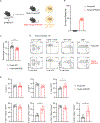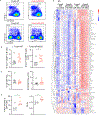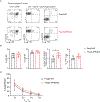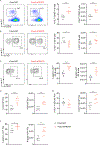Activated PI3Kδ Specifically Perturbs Mouse Regulatory T Cell Homeostasis and Function Leading to Immune Dysregulation
- PMID: 38829130
- PMCID: PMC11232928
- DOI: 10.4049/jimmunol.2400032
Activated PI3Kδ Specifically Perturbs Mouse Regulatory T Cell Homeostasis and Function Leading to Immune Dysregulation
Abstract
FOXP3+ regulatory T cells (Treg) are required for maintaining immune tolerance and preventing systemic autoimmunity. PI3Kδ is required for normal Treg development and function. However, the impacts of dysregulated PI3Kδ signaling on Treg function remain incompletely understood. In this study, we used a conditional mouse model of activated PI3Kδ syndrome to investigate the role of altered PI3Kδ signaling specifically within the Treg compartment. Activated mice expressing a PIK3CD gain-of-function mutation (aPIK3CD) specifically within the Treg compartment exhibited weight loss and evidence for chronic inflammation, as demonstrated by increased memory/effector CD4+ and CD8+ T cells with enhanced IFN-γ secretion, spontaneous germinal center responses, and production of broad-spectrum autoantibodies. Intriguingly, aPIK3CD facilitated Treg precursor development within the thymus and an increase in peripheral Treg numbers. Peripheral Treg, however, exhibited an altered phenotype, including increased PD-1 expression and reduced competitive fitness. Consistent with these findings, Treg-specific aPIK3CD mice mounted an elevated humoral response following immunization with a T cell-dependent Ag, which correlated with a decrease in follicular Treg. Taken together, these findings demonstrate that an optimal threshold of PI3Kδ activity is critical for Treg homeostasis and function, suggesting that PI3Kδ signaling in Treg might be therapeutically targeted to either augment or inhibit immune responses.
Copyright © 2024 by The American Association of Immunologists, Inc.
Figures








Update of
-
Activated PI3Kδ specifically perturbs mouse Treg homeostasis and function leading to immune dysregulation.bioRxiv [Preprint]. 2023 Dec 23:2023.12.21.569665. doi: 10.1101/2023.12.21.569665. bioRxiv. 2023. Update in: J Immunol. 2024 Jul 15;213(2):135-147. doi: 10.4049/jimmunol.2400032. PMID: 38187650 Free PMC article. Updated. Preprint.
Similar articles
-
Activated PI3Kδ specifically perturbs mouse Treg homeostasis and function leading to immune dysregulation.bioRxiv [Preprint]. 2023 Dec 23:2023.12.21.569665. doi: 10.1101/2023.12.21.569665. bioRxiv. 2023. Update in: J Immunol. 2024 Jul 15;213(2):135-147. doi: 10.4049/jimmunol.2400032. PMID: 38187650 Free PMC article. Updated. Preprint.
-
Interferon Regulatory Factor 4 dose-dependently controls peripheral Treg cell differentiation and homeostasis by modulating chromatin accessibility in mice.Front Immunol. 2025 Jul 14;16:1604888. doi: 10.3389/fimmu.2025.1604888. eCollection 2025. Front Immunol. 2025. PMID: 40726986 Free PMC article.
-
Comprehensive single-cell chromatin and transcriptomic profiling of peripheral immune cells in nonsegmental vitiligo.Br J Dermatol. 2025 Jun 20;193(1):115-124. doi: 10.1093/bjd/ljaf041. Br J Dermatol. 2025. PMID: 39888372
-
Role of the intestinal flora-immunity axis in the pathogenesis of rheumatoid arthritis-mechanisms regulating short-chain fatty acids and Th17/Treg homeostasis.Mol Biol Rep. 2025 Jun 21;52(1):617. doi: 10.1007/s11033-025-10714-w. Mol Biol Rep. 2025. PMID: 40544212 Review.
-
Regulatory T-cells and immune tolerance in pregnancy: a new target for infertility treatment?Hum Reprod Update. 2009 Sep-Oct;15(5):517-35. doi: 10.1093/humupd/dmp004. Epub 2009 Mar 11. Hum Reprod Update. 2009. PMID: 19279047 Free PMC article.
Cited by
-
PI3Kδ as a Novel Therapeutic Target for Aggressive Prostate Cancer.Cancers (Basel). 2025 May 9;17(10):1610. doi: 10.3390/cancers17101610. Cancers (Basel). 2025. PMID: 40427108 Free PMC article. Review.
-
Genetic and epigenetic regulation of Treg cell fitness by autism-related chromatin remodeler CHD8.Cell Mol Biol Lett. 2025 Mar 28;30(1):36. doi: 10.1186/s11658-025-00711-z. Cell Mol Biol Lett. 2025. PMID: 40155813 Free PMC article.
References
-
- Hori S, Nomura T, and Sakaguchi S. 2003. Control of regulatory T cell development by the transcription factor Foxp3. Science 299: 1057–1061. - PubMed
-
- Fontenot JD, Gavin MA, and Rudensky AY. 2003. Foxp3 programs the development and function of CD4+CD25+ regulatory T cells. Nat Immunol 4: 330–336. - PubMed
-
- Huynh A, Zhang R, and Turka LA. 2014. Signals and pathways controlling regulatory T cells. Immunol Rev 258: 117–131. - PubMed
-
- Preite S, Gomez-Rodriguez J, Cannons JL, and Schwartzberg PL. 2019. T and B-cell signaling in activated PI3K delta syndrome: From immunodeficiency to autoimmunity. Immunol Rev 291: 154–173. - PubMed
Publication types
MeSH terms
Substances
Supplementary concepts
Grants and funding
LinkOut - more resources
Full Text Sources
Molecular Biology Databases
Research Materials
Miscellaneous

